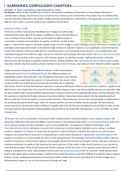Samenvatting
Summary Compulsory Chapters - Marketing Communication
This summary contains all information of the mandatory/relevant chapters of the book Marketing Communications: A European Perspective (6th edition), for the course ''Marketing Communication'' at Tilburg University. Note: This summary was created as preparation for the exam in Spring 2020! The chapt...
[Meer zien]





